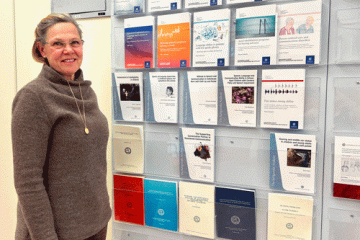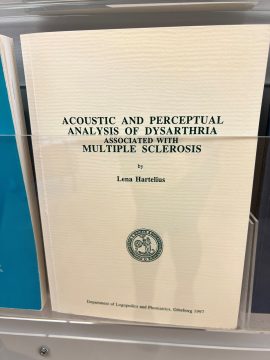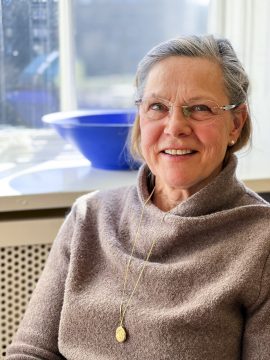PEOPLE. In the early 1980s, Professor Lena Hartelius was one of the very first speech therapists to be trained in Gothenburg. Now that she is retiring almost 40 years later, she can see that speech therapy as an academic subject has significant advancements but is not entirely without setbacks.

When the Speech and Language Pathology Program in Gothenburg began in 1980, Lena Hartelius was one of the first students to be admitted. In June 2022, she will retire after more than 40 years in speech therapy at the University of Gothenburg.
“Many of us have campaigned to have the program extended and expanded and to improve opportunities for speech therapy research. To some extent, it has been a bumpy road,” says Hartelius.
“In the beginning, the training lasted three years, and the first course had only 12 students. Today we have a four-year program and are on our way to an admission of 30 students per class. At that point we will have 120 students enrolled simultaneously. This is likely the pain threshold for financially viability of undergraduate studies.”
Various neurological speech disorders

Nine of the first speech therapy students received their degrees in 1983, and Lena Hartelius was one of them. Even then she was inclined to continue working with speech therapy in academia. In the early years she worked as a part-time teaching assistant, and with the establishment of doctoral studies in speech therapy in the late 1980s, she became a doctoral student. In 1997 she defended her doctoral thesis on speech disorders in connection with multiple sclerosis (MS) and has since continued her research on how neurological disorders affect speech and communication.
“Speech therapy has always belonged to the Faculty of Medicine, but it was not self-evident that we could start doctoral studies. The allocation model of the time for faculty funding of research and doctoral education also complicated matters. Funding had been frozen based on the number of professors a subject had, and we did not yet have any professors then.”
For much of her time as an assistant professor and later professor of speech therapy, she has combined her academic position with work as a speech therapist. Since 2017, she has worked at Skaraborg Hospital in Skövde, where she and her colleagues conduct clinical and patient-related research with patients with various neurological speech disorders, such as those caused by Parkinson’s disease, MS, and stroke. Combined positions are an ideal way to maintain contact with clinical reality, which of course benefits both teaching and research, Hartelius points out.
Small victories
In hindsight, it can be noted that doctoral studies in speech and language pathology have worked out well. A total of 28 speech therapists have defended their theses in Gothenburg, including eight in the related subjects of linguistics and otolaryngology. Of the 20 who have defended their theses specifically in speech therapy, five have become professors in the subject.

“I think Gothenburg has really contributed to the discipline of speech and language pathology in Sweden. We have nothing to be ashamed of. At the same time, in many ways the subject is still invisible. For example, speech therapy is not listed at a visible level in the standard for the Swedish classification of research subjects maintained by Statistics Sweden.”
She illustrates how persistent work through the years has led to a series of victories for speech therapy research. From being fully funded by external grants from the Swedish Research Council and other funding bodies, the subject now also receives direct government funding.
Changing behaviors
Examples of research tracks in speech therapy in Gothenburg are speech, language, and communication that can involve children with development-related speech and language disorders, such as genetic syndromes, cleft lip and palate, stuttering, autism, or multi-function disabilities. For adults with different types of acquired speech, language, and communication problems, we now focus on neurologically conditioned changes to find words and communicate in everyday life and how writing ability is affected. Some research also relates to the domain person-centered care.
Speech therapy research deals largely with seeing how communication and swallowing problems are associated with various diseases and conditions and how these problems change over time for both the growing individual and for someone affected by illness. Conducting good intervention research that provides evidence-based treatment methods poses a major challenge for speech therapy research.
“Of course, this is something that engages researchers around the world as they attempt to define the results of treatment in their field and evaluate them.”
Speech therapy treatment aims to support development or modify communicative behaviors and create new approaches and strategies for those affected.
“All patients are different, and it is very difficult to create homogeneous groups where treatment can be evaluated through randomized group studies. But we are well on the way. Work on creating clinical guidelines for neurologically conditioned speech disorders is now underway, and the number of systematic reviews gives us hope.”
Broad area
In education, the Speech and Language Pathology Program has been able to make the case to increase the number of students and, thereby, full-time equivalent students (HST) for which the program receives compensation. In recent years, the program has also been greatly adapted to respond to the development of the profession. Speech therapists can now also be found outside of healthcare. They can also contribute elsewhere, such as in municipalities and schools. Efforts to expand teaching and learning skills by the program’s teachers has resulted in two Sahlgrenska Academy Pedagogical Awards: to Charlotta Saldert in 2015 and to Tove Lagerberg and Marja Öller Darelid in 2021.
Speech therapy is multidisciplinary and based on linguistics, psychology, and medicine. People that speech therapists help in their profession can have a wide variety of diseases and conditions that affect speech and swallowing ability, and patient ages range from cradle to grave.
“The complexity of speech therapy makes it difficult to teach everything in four years. During the 2000s, there was a great deal of work in which all higher education institutions agreed on a proposal to expand instruction by an additional year, making it a five-year program, but the speech therapists’ professional organization opposed the expansion. Now the question of a five-year speech and language pathology program has been shelved. However, other countries, including Finland, have adopted a five-year program.”
Master’s degree and specialist competence
The solution instead became the completely new Speech and Language Pathology Program, with the first students graduating this spring. It is still a four-year program, but the syllabus has been redesigned from the ground up to ensure that students gain all the knowledge they need. If they wish, students can augment their education with a master’s degree in speech therapy, which can be included in a portfolio to apply for specialist competence.
“As for the future of speech therapy in Gothenburg, I am not worried,” concludes Lena Hartelius. “There is a whole new generation of PhD, clinically well-grounded, and very committed speech therapists waiting in the wings. It is important that they step forward.”
By ELIN LINDSTRÖM










